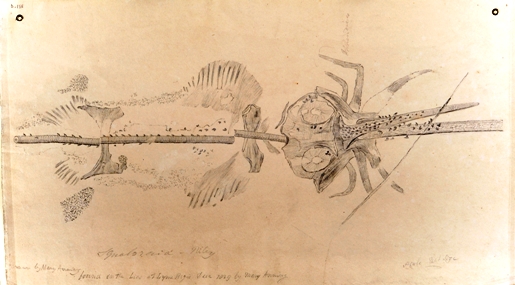
Geologist and science writer Nina Morgan reports on remarkable creatures, a fishy tale and a lucky miss.
Geoscientist 21.02 March 2011
Among many fascinating specimens collected by Mary Anning (1799 – 1847 - arguably one of the most important and talented collectors who worked along the Jurassic coast near Lyme Regis – was a complete skeleton of the fish,
Squaloraja polyspondyla, believed to be a transitional link between sharks and rays.
According to a communication printed in the
Transactions of the Geological Society of London (1887), the specimen had been purchased by John Naish Sanders, Esq. Sanders – who acted under the assumed name of 'An Aged Citizen' - was a moving spirit behind the Bristol Institution, to which he donated the fossil and "where it now constitutes a part of that valuable and improving collection." 'Part', apparently, was the operative word. It seems that Sanders initially received only its body. He expected to receive the tail later.
In a letter dating from February 1838 preserved in the archives at the Oxford University Museum of Natural History (OUMNS), Sanders wrote to Mary Anning's friend and fellow collector, Elizabeth Philpot, to enquire about the missing tail.
"... I believe you are already aware," he wrote, "that I purchased of Miss Anning, some years ago a rare, fossil, described by Monr. Agassiz, of which there is a large plate in the last report of the Geological Transactions. If Miss A. had not forgotten her promise to me, a portion of the tail, subsequently found, would now be attached to the fossil.
"Should you be of the opinion that science would be promoted by a reunion, I should be most happy to pay any expense that you have incurred, for the fragment in your possession.
"I can sincerely assure you that I have no personal interest in view, having already offered the fossil, gratuitously, to a public museum, to prevent so valuable a specimen leaving this Country ...”
Body and tail were never reunited - luckily, as it turned out. The body was lost in the Bristol blitz. Happily the tail, along with a drawing by Mary Anning of the skull and body, survive and have been recently displayed as part of a fascinating temporary exhibit, Remarkable Creatures, Remarkable Finds, at the OUMS.
Acknowledgments
- The story about Squaloraja forms part of a temporary exhibit entitled Remarkable Creatures, Remarkable finds at the Oxford University Museum of Natural History. The exhibit, which focuses on Mary Anning and Elizabeth Philpot includes specimens, drawings and letters, was researched and assembled by Caroline Cheeseman, Eliza Howlett, Paul Jeffery and Joy Todd.
- If the past is the key to your present interests, why not join the History of Geology Group (HOGG)? For more information and to read the latest HOGG newsletter, visit: www.geolsoc.org.uk/hogg. Keen collectors will note that registration for the HOGG Conference on Geological Collectors and Collecting is now open. A full programme and registration form are available for download from the HOGG website.
* Nina Morgan is a geologist and science writer based near Oxford.